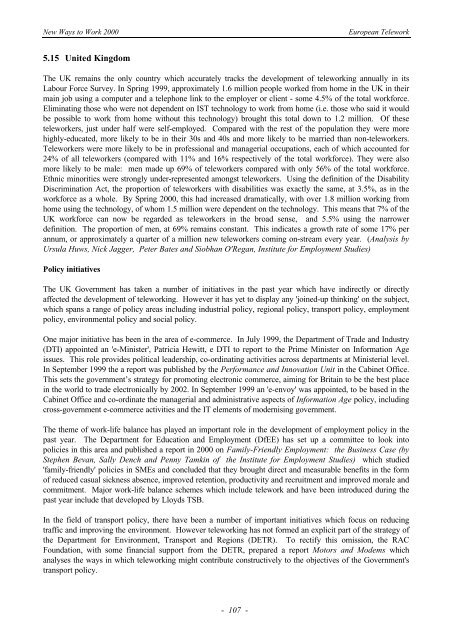eWORK 2000 - European Telework Week
eWORK 2000 - European Telework Week
eWORK 2000 - European Telework Week
- No tags were found...
You also want an ePaper? Increase the reach of your titles
YUMPU automatically turns print PDFs into web optimized ePapers that Google loves.
New Ways to Work <strong>2000</strong><strong>European</strong> <strong>Telework</strong>5.15 United KingdomThe UK remains the only country which accurately tracks the development of teleworking annually in itsLabour Force Survey. In Spring 1999, approximately 1.6 million people worked from home in the UK in theirmain job using a computer and a telephone link to the employer or client - some 4.5% of the total workforce.Eliminating those who were not dependent on IST technology to work from home (i.e. those who said it wouldbe possible to work from home without this technology) brought this total down to 1.2 million. Of theseteleworkers, just under half were self-employed. Compared with the rest of the population they were morehighly-educated, more likely to be in their 30s and 40s and more likely to be married than non-teleworkers.<strong>Telework</strong>ers were more likely to be in professional and managerial occupations, each of which accounted for24% of all teleworkers (compared with 11% and 16% respectively of the total workforce). They were alsomore likely to be male: men made up 69% of teleworkers compared with only 56% of the total workforce.Ethnic minorities were strongly under-represented amongst teleworkers. Using the definition of the DisabilityDiscrimination Act, the proportion of teleworkers with disabilities was exactly the same, at 3.5%, as in theworkforce as a whole. By Spring <strong>2000</strong>, this had increased dramatically, with over 1.8 million working fromhome using the technology, of whom 1.5 million were dependent on the technology. This means that 7% of theUK workforce can now be regarded as teleworkers in the broad sense, and 5.5% using the narrowerdefinition. The proportion of men, at 69% remains constant. This indicates a growth rate of some 17% perannum, or approximately a quarter of a million new teleworkers coming on-stream every year. (Analysis byUrsula Huws, Nick Jagger, Peter Bates and Siobhan O'Regan, Institute for Employment Studies)Policy initiativesThe UK Government has taken a number of initiatives in the past year which have indirectly or directlyaffected the development of teleworking. However it has yet to display any 'joined-up thinking' on the subject,which spans a range of policy areas including industrial policy, regional policy, transport policy, employmentpolicy, environmental policy and social policy.One major initiative has been in the area of e-commerce. In July 1999, the Department of Trade and Industry(DTI) appointed an 'e-Minister', Patricia Hewitt, e DTI to report to the Prime Minister on Information Ageissues. This role provides political leadership, co-ordinating activities across departments at Ministerial level.In September 1999 the a report was published by the Performance and Innovation Unit in the Cabinet Office.This sets the government’s strategy for promoting electronic commerce, aiming for Britain to be the best placein the world to trade electronically by 2002. In September 1999 an 'e-envoy' was appointed, to be based in theCabinet Office and co-ordinate the managerial and administrative aspects of Information Age policy, includingcross-government e-commerce activities and the IT elements of modernising government.The theme of work-life balance has played an important role in the development of employment policy in thepast year. The Department for Education and Employment (DfEE) has set up a committee to look intopolicies in this area and published a report in <strong>2000</strong> on Family-Friendly Employment: the Business Case (byStephen Bevan, Sally Dench and Penny Tamkin of the Institute for Employment Studies) which studied'family-friendly' policies in SMEs and concluded that they brought direct and measurable benefits in the formof reduced casual sickness absence, improved retention, productivity and recruitment and improved morale andcommitment. Major work-life balance schemes which include telework and have been introduced during thepast year include that developed by Lloyds TSB.In the field of transport policy, there have been a number of important initiatives which focus on reducingtraffic and improving the environment. However teleworking has not formed an explicit part of the strategy ofthe Department for Environment, Transport and Regions (DETR). To rectify this omission, the RACFoundation, with some financial support from the DETR, prepared a report Motors and Modems whichanalyses the ways in which teleworking might contribute constructively to the objectives of the Government'stransport policy.- 107 -








